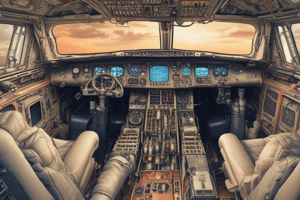Podcast
Questions and Answers
What is the definition of avionics?
What is the definition of avionics?
- Electronics as applied to aviation. (correct)
- The study of aviation laws and regulations.
- Application of advanced integrated circuits in aviation.
- Mechanics applied to aviation.
Avionics typically represent a small cost component of modern combat aircraft.
Avionics typically represent a small cost component of modern combat aircraft.
False (B)
What was a key characteristic of avionics in the 1950s-60s?
What was a key characteristic of avionics in the 1950s-60s?
- Rapid growth in computing power through software implementations.
- Introduction of digital ICs.
- Transistor-based analog circuits leading to greater reliability and miniaturization. (correct)
- Use of valve-based analog circuits.
Which decade saw the introduction of digital ICs in avionics?
Which decade saw the introduction of digital ICs in avionics?
During the 1980s-90s, there was a rapid growth in ______ power, with functions increasingly implemented in software.
During the 1980s-90s, there was a rapid growth in ______ power, with functions increasingly implemented in software.
What is the role of hybrid chips & ASICs in microelectronic devices?
What is the role of hybrid chips & ASICs in microelectronic devices?
Which of the following constitutes a key function of hybrid chips and ASICs?
Which of the following constitutes a key function of hybrid chips and ASICs?
The obsolescence of chips is not a challenge in the design of avionics systems.
The obsolescence of chips is not a challenge in the design of avionics systems.
Which type of memory device typically stores application software?
Which type of memory device typically stores application software?
What is the primary function of RAM in avionics systems?
What is the primary function of RAM in avionics systems?
What is one impact of using digital data buses in avionics systems?
What is one impact of using digital data buses in avionics systems?
What is a primary benefit of digital data buses in avionics?
What is a primary benefit of digital data buses in avionics?
The Experimental Aircraft Programme (EAP) did not use MIL-STD-1553B.
The Experimental Aircraft Programme (EAP) did not use MIL-STD-1553B.
Which aircraft system used ARINC 429 buses to link multiple system controllers with avionics displays?
Which aircraft system used ARINC 429 buses to link multiple system controllers with avionics displays?
The Boeing 777 features the adoption of the ______ bus to integrate flight controls, avionics, and aircraft systems.
The Boeing 777 features the adoption of the ______ bus to integrate flight controls, avionics, and aircraft systems.
What is the main purpose of Line Replaceable Units (LRUs) in avionics packaging standards?
What is the main purpose of Line Replaceable Units (LRUs) in avionics packaging standards?
Which of the following is a standard form-factor for LRUs?
Which of the following is a standard form-factor for LRUs?
What does MCU stand for in avionics packaging standards?
What does MCU stand for in avionics packaging standards?
A Modular Concept Unit (MCU) is equivalent to approximately 5 inches.
A Modular Concept Unit (MCU) is equivalent to approximately 5 inches.
What is the typical size of small controllers in terms of MCUs?
What is the typical size of small controllers in terms of MCUs?
Roughly, how big are complex LRUs (such as combined ADIRS)?
Roughly, how big are complex LRUs (such as combined ADIRS)?
A Power Supply Unit (PSU) converts aircraft power to low-voltage ______ rails.
A Power Supply Unit (PSU) converts aircraft power to low-voltage ______ rails.
What is the main function of a Power Supply Unit (PSU) in LRU architecture?
What is the main function of a Power Supply Unit (PSU) in LRU architecture?
Name one environmental challenge that avionics components must withstand.
Name one environmental challenge that avionics components must withstand.
Environmental and EMI challenges are insignificant in avionics design.
Environmental and EMI challenges are insignificant in avionics design.
Which of the following is an internal block commonly found in a typical LRU?
Which of the following is an internal block commonly found in a typical LRU?
Integrated Modular Avionics (IMA) moves beyond discrete ARINC 600 LRUs to shared computing resources in integrated ______.
Integrated Modular Avionics (IMA) moves beyond discrete ARINC 600 LRUs to shared computing resources in integrated ______.
What is the central concept behind Integrated Modular Avionics (IMA)?
What is the central concept behind Integrated Modular Avionics (IMA)?
Name one advantage of Integrated Modular Avionics (IMA).
Name one advantage of Integrated Modular Avionics (IMA).
Integrated Modular Avionics makes system upgrades more difficult.
Integrated Modular Avionics makes system upgrades more difficult.
What does the transition to Integrated Modular Avionics (IMA) primarily involve?
What does the transition to Integrated Modular Avionics (IMA) primarily involve?
Match the historical periods with the corresponding advancements in avionics:
Match the historical periods with the corresponding advancements in avionics:
Which characteristic is NOT associated with the transition from traditional avionics to Integrated Modular Avionics (IMA)?
Which characteristic is NOT associated with the transition from traditional avionics to Integrated Modular Avionics (IMA)?
In the context of avionics, what is the most significant implication of rapid obsolescence of microelectronic chips?
In the context of avionics, what is the most significant implication of rapid obsolescence of microelectronic chips?
Considering the environmental and EMI challenges described, which design consideration is most crucial for avionics destined for high-altitude flight?
Considering the environmental and EMI challenges described, which design consideration is most crucial for avionics destined for high-altitude flight?
Explain the trade-offs involved in choosing between ROM and RAM for avionics software storage, considering factors such as data volatility and update frequency.
Explain the trade-offs involved in choosing between ROM and RAM for avionics software storage, considering factors such as data volatility and update frequency.
An aircraft manufacturer decides to adopt a new Integrated Modular Avionics (IMA) architecture. Which of the following best describes the initial impact on their supply chain and maintenance procedures?
An aircraft manufacturer decides to adopt a new Integrated Modular Avionics (IMA) architecture. Which of the following best describes the initial impact on their supply chain and maintenance procedures?
The primary reason for the adoption of ARINC 629 bus in the Boeing 777 was to reduce the computational load on individual processors, not to integrate different aircraft systems.
The primary reason for the adoption of ARINC 629 bus in the Boeing 777 was to reduce the computational load on individual processors, not to integrate different aircraft systems.
In the context of LRU architecture, the Power Supply Unit is essential for regulating both voltage and ______, ensuring stable and safe operation of sensitive avionics components.
In the context of LRU architecture, the Power Supply Unit is essential for regulating both voltage and ______, ensuring stable and safe operation of sensitive avionics components.
You are tasked with selecting memory chips for a new avionics system that requires storing both critical system software and operational flight data. Given the need for data retention without power and the ability to update flight data, what combination of memory types would be most appropriate?
You are tasked with selecting memory chips for a new avionics system that requires storing both critical system software and operational flight data. Given the need for data retention without power and the ability to update flight data, what combination of memory types would be most appropriate?
Describe a scenario where the benefits of Integrated Modular Avionics (IMA) would significantly outweigh the costs and complexities of its implementation in a next-generation commercial airliner, and explain why.
Describe a scenario where the benefits of Integrated Modular Avionics (IMA) would significantly outweigh the costs and complexities of its implementation in a next-generation commercial airliner, and explain why.
Flashcards
Avionics Definition
Avionics Definition
Electronics applied to aviation.
Cost Impact of Avionics
Cost Impact of Avionics
The largest single cost component on modern combat aircraft.
Avionics in the 1940s
Avionics in the 1940s
Valve-based analog circuits used in early airborne radar and IFF systems.
Avionics in the 1950s-60s
Avionics in the 1950s-60s
Signup and view all the flashcards
Avionics in the 1960s-70s
Avionics in the 1960s-70s
Signup and view all the flashcards
Avionics in the 1980s-90s
Avionics in the 1980s-90s
Signup and view all the flashcards
Hybrid Chips & ASICs Role
Hybrid Chips & ASICs Role
Signup and view all the flashcards
Key Functions of Hybrid Chips & ASICs
Key Functions of Hybrid Chips & ASICs
Signup and view all the flashcards
Processors in the 1970s
Processors in the 1970s
Signup and view all the flashcards
Processors in the 1980s Onward
Processors in the 1980s Onward
Signup and view all the flashcards
Challenge with Processors
Challenge with Processors
Signup and view all the flashcards
ROM (Read-Only Memory)
ROM (Read-Only Memory)
Signup and view all the flashcards
RAM (Random-Access Memory)
RAM (Random-Access Memory)
Signup and view all the flashcards
Impact of Digital Data Buses
Impact of Digital Data Buses
Signup and view all the flashcards
Benefits of Digital Data Buses
Benefits of Digital Data Buses
Signup and view all the flashcards
EAP & MIL-STD-1553B
EAP & MIL-STD-1553B
Signup and view all the flashcards
Integrated Functions (EAP)
Integrated Functions (EAP)
Signup and view all the flashcards
Airbus A330/A340 & ARINC 429
Airbus A330/A340 & ARINC 429
Signup and view all the flashcards
Boeing 777 & ARINC 629
Boeing 777 & ARINC 629
Signup and view all the flashcards
Purpose of LRUs
Purpose of LRUs
Signup and view all the flashcards
Standard Form Factor
Standard Form Factor
Signup and view all the flashcards
Power Supply Unit (PSU)
Power Supply Unit (PSU)
Signup and view all the flashcards
Concept of IMA
Concept of IMA
Signup and view all the flashcards
Advantages of IMA
Advantages of IMA
Signup and view all the flashcards
Study Notes
- "Avionics" means electronics applied to aviation, coined in the 1940s for "Aviation Electronics."
- Avionics is the largest single cost component on modern combat aircraft, about 50% of the F-22 Raptor platform cost.
Historical Evolution of Avionics
- 1940s: Valve-based analog circuits were used for early airborne radar (IFF).
- 1950s-60s: Transistor-based analog circuits led to greater reliability and miniaturization.
- 1960s-70s: Digital ICs were introduced, increasing accuracy.
- 1980s-90s: Rapid growth in computing power led to functions being implemented in software alongside hardware.
Nature of Microelectronic Devices: Hybrid Chips & ASICs
- These interface the analog world (sensors/actuators) to digital systems.
- Key functions include A/D and D/A conversion, and I/O buffering
Processors
- 1970s: 4-bit micros evolved to 8-bit then 16-bit by the late 1970s.
- 1980s onward: 32-bit CPUs such as the Motorola 68000 used in Eurofighter Typhoon and Boeing 777 became common.
- A challenge is rapid obsolescence, increasing the need for costly redesigns if chips become unavailable.
Memory Devices
- ROM (Read-Only Memory) stores application software, with variants like EPROM.
- RAM (Random-Access Memory) is read/write program working memory; early types needed backup power, while newer devices need less.
Digital Data Buses
- Digital data buses replaced extensive point-to-point wiring with standardized serial links (2-4 wires).
- Benefits are reduced weight and complexity, and easier system integration and diagnostics
Data Bus Integration Examples: Experimental Aircraft Programme (EAP)
- It was the first to apply MIL-STD-1553B for full aircraft systems.
- Functions like engine control, fuel management, hydraulics, environmental control, and power systems were integrated.
Airbus A330/A340
- ARINC 429 buses link multiple system controllers (fuel, hydraulics, landing gear, etc.) with avionics displays.
Boeing 777
- Adoption of ARINC 629 bus integrates flight controls, avionics, and aircraft systems on a single network.
Avionics Packaging Standards: Line Replaceable Units (LRUs)
- The purpose is modular replacement of functional elements with minimal aircraft downtime.
- Standard form-factors include Air Transport Radio (ATR) and Modular Concept Unit (MCU), where 1 MCU = 1½ inches.
Typical LRU Sizes
- Small controllers are ~2 MCU.
- Complex units (e.g., combined ADIRS) are 8–10 MCU.
Typical LRU Architecture
- The Power Supply Unit (PSU) converts 115 VAC or 28 VDC aircraft power to low-voltage DC rails (+5 V, ±15 V).
- Environmental & EMI challenges: Components withstand vibration, temperature extremes, and electromagnetic interference.
- Internal blocks: Processor, memory, ASICs, I/O interfaces, data-bus transceivers.
Integrated Modular Avionics (IMA)
- It moves beyond discrete ARINC 600 LRUs to shared computing resources in integrated cabinets.
- Advantages are further reduction in weight and wiring and easier upgrades and reconfiguration via software partitions.
- It transitions from many small LRUs to fewer, more capable modular avionics units.
Studying That Suits You
Use AI to generate personalized quizzes and flashcards to suit your learning preferences.




